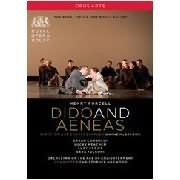This performance of Purcell’s Dido and Aeneas, recorded at the Royal Opera House, Covent Garden in April, 2008, has some great things going for it. The almost-minimalist sets by Hildegard Bechtler have an asceticism about them that superbly mirror the opera’s content: a bare stage at the start with an open rectangle in which colors change with moods; later a clump of autumnal trees; even later what appears to be a ruined ship; and finally, absolutely nothing for the final number, save, after Dido’s farewell, impressionistic projections in royal blue, with images of a galloping horse. (This last effect is more subtle than what it sounds like.)
Fotini Dimou’s costumes are the same for the men and women of the chorus–long, full shirts over long, full skirts, mostly in browns and grays. The Sorceress and witches wear deep blue–and the two witches appear as conjoined twins, a nice, eerie effect. The Royal Ballet’s resident choreographer, Wayne McGregor, who also acts as director, has devised dance sequences where Purcell calls for them: A combination of modern, stiff-armed, vogue-ing, and Michael Jacksonian poses incorporating long-armed, sweeping Classical ballet movements, they’re beautifully performed. But they’re also generic–triumph, furies, witches, sailors–all very similar. As filler, they’re exquisite, but they don’t shed light on or enact the drama.
Musically, Christopher Hogwood leads the Orchestra of the Age of Enlightenment with spring and energy, although he is highly sensitive in the introspective, tender, and tragic moments. His continuo section–harpsichord, theorbo, cello, and chamber organ–is impressive, and he can get a true rumble out of the whole band very effectively (the music before the Witches’ Dance truly growls). His is not a dainty performance–there is plenty of vibrato from singers and players alike–and orchestra and chorus are as remarkably expressive as they are musically solid and certain.
The cast varies. Lucas Meacham is an impressive Aeneas, catching the character’s wavering loyalties well, but his singing style is more Verdian than Purcellian. Pumeza Matshikiza and Eri Nakamura look better than they sound as the Witches, and Sara Fulgoni’s Sorceress is far from terrifying and not easy to understand. Anita Watson’s Second Woman is poorly sung. Iestyn Davies’ off-stage Spirit is fine, as is Ji-Min Park’s Sailor.
The two leading women are sensational. Lucy Crowe’s Belinda, always alert to her mistress’ feelings, looks lovely and sings with pure tone and impeccable diction. And enough praise cannot be heaped on Sarah Connolly, whose Dido is the most effective I’ve heard. The role’s tessitura is indeed her absolute comfort zone: her singing is as natural as speech. Sad at the start, enchanted by her new-found love, startled and then resigned by his treachery, her performance grows and grows in stature.
In a marvelously sensitive move, before “When I am laid in earth” we see blood coming from Dido’s wrists, and Belinda takes her long dress and wraps her mistress’ wounds in an attempt to stop the bleeding. The effect is stunning, but not as stunning as Connolly’s rendition of the recit and aria themselves, during which she sinks very slowly to the floor and, at the end, dies. Small embellishments dot the aria but the flow is never broken. Belinda cradles her in her arms. The chorus, dimly lit, sings its final song and with Belinda departs one at a time as the stage goes dark, leaving a light only on Dido’s dead body. These last few minutes are as powerful a time at the opera as we’re bound to see.
And so, not a perfect Dido, but necessary for Connolly’s and Crowe’s performances and for the overall musical preparation by Hogwood. Sound and picture are crystal-clear and subtitles are in all major European languages. A 10-minute interview with Wayne McGregor is somewhat enlightening; indeed, more-so than the dances themselves. As for other versions, a 1995 release on Kultur starring Maria Ewing is filmed and feels artificial; Mark Morris’ production (on Image, no longer available) is danced. He stars as both Dido and the Sorceress, while Jennifer Lane sings the parts. It isn’t the opera as we know it.
































